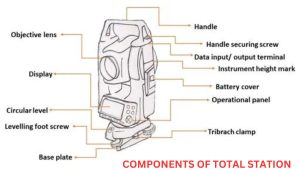A total station is an advanced surveying tool that helps people measure distances, angles, and elevations accurately. It’s used in construction and land surveying to make maps, measure land features, and determine property boundaries. One person operates it using a controller or computer, with features like data storage and real-time data transfer. It’s constructive because it makes surveying projects more efficient and accurate.

Components of the Total Station
The main components of an Instrument are.
1. Telescope
The telescope is the main part of a total station used to observe the target and measure angles.
2. E.D.M
An E.D.M is a device that uses electromagnetic waves to measure distances between the total station and the target.
3. Microprocessor
The microprocessor is the brain of the total station that performs calculations and stores data.
4. Battery
The instruments are powered by rechargeable batteries that provide electrical power to the instrument.
5. Control Panel
The control panel is a user interface that allows the surveyor to operate the instrument and access its features.
6. Data storage
The instrument have built-in data storage that allows surveyors to store and transfer data.
7. Tri-brunch
The Tri-brunch is a device that attaches the instrument to a tripod.

The setting of Total Station
There are two types of instrument settings.
1. Temporary setting of Total Station
The temporary setting of the total station means to make the instrument ready for work.
The temporary setting of the instrument consists of three basic processes. centering, leveling, and focusing.
Centering.
Centering the instrument means putting the instrument on a tripod over a point, making sure it’s level and pointing correctly. This is important for accurate measurements. Once it’s centered, the angles are set to zero and checked. You need to periodically check the centering during the survey to make sure measurements are accurate.
Leveling.
Leveling of instrument means making sure the instrument is level and stable on the tripod, which is important for accurate measurements. To level it, adjust the tripod and leveling screws until the bubble on the instrument is centered. Remember to periodically check the level during the survey to ensure accuracy.
Focusing.
Focusing the total station means adjusting the telescope’s focus so that the target object is clear and sharp for accurate measurements. To focus, adjust the focus ring and use the eyepiece adjustment for fine-tuning. Check the focus periodically during the survey to ensure accuracy.
2. Permanent Setting of Total Station
To permanently set up the instrument.
Find a stable location with clear visibility.
Prepare the area and ensure a level surface.
Install a secure mounting system.
Create a stable base to minimize movement.
Calibrate and align the instrument for accurate measurements. This allows for consistent and reliable use at that location over time.
Conclusion
In conclusion, the instrument is an advanced survey equipment used to measure land. it is used for topography, stakeout resection, and area calculation. Moreover, the instrument is also used to work more accurately and fast.
